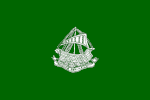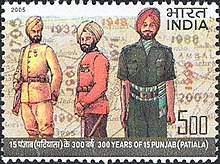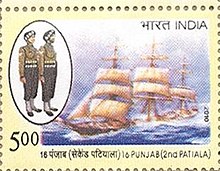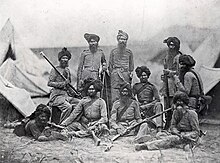
The 4th Indian Infantry Division, also known as the Red Eagle Division, is an infantry division of the Indian Army. This division of the British Indian Army was formed in Egypt in 1939 during the Second World War. During the Second World War, it took part in campaigns in East Africa, Syria, North Africa and Italy. Post independence, the division is part of the I Corps and headquartered at Prayagraj.
39th Indian Infantry Division was an infantry division of the Indian Army during World War II, which became a training division in 1943 after its recovery into India from Burma. The division was re-raised after independence and 39 Mountain Division is presently located in Palampur, Himachal Pradesh under XVI Corps.

The North-West Frontier was a region of the British Indian Empire. It remains the western frontier of present-day Pakistan, extending from the Pamir Knot in the north to the Koh-i-Malik Siah in the west, and separating the modern Pakistani frontier regions of North-West Frontier Province, Federally Administered Tribal Areas and Balochistan from neighbouring Afghanistan in the west. The borderline between is officially known as the Durand Line and divides Pashtun inhabitants of these provinces from Pashtuns in eastern Afghanistan.
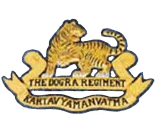
The Dogra Regiment is an infantry regiment of the Indian Army. The regiment traces its roots directly from the 17th Dogra Regiment of the British Indian Army. When transferred to the Indian Army like its sister regiments, the numeral prefix was removed. Dogra Regiment Units Maximum filled with Rajputs And Sikh. Units of the Dogra Regiment have fought in all conflicts that independent India has been engaged in, making it one of the most prestigious and most decorated regiments of the Indian Army.

The Brigade of The Guards is a mechanised infantry regiment of the Indian Army. It was raised as the first "all India", "all class" infantry unit of the Army where troops from all parts of India serve together, as opposed to other regiments that recruit from specific regions, ethnic groups or religions.

The Parachute Regiment is an airborne and special forces regiment of the Indian Army. It was raised in 1945 as part of the British Indian Army but was disbanded after World War II and was re-raised in 1952 as part of the Indian Army. Currently it consists of fifteen Special Forces, two Territorial Army and one Rashtriya Rifles battalions.

The Kumaon Regiment is one of the oldest infantry regiments of the Indian Army. The regiment traces its origins to the 18th century and has fought in every major campaign of the British Indian Army and the Indian Army, including the two world wars, and is one of the highest decorated regiments of the Indian Army.

The Mahar Regiment is an infantry regiment of the Indian Army. Although it was originally intended to be a regiment consisting of troops from the Mahar community of Maharashtra, today the Mahar Regiment is composed of different communities from mainly states like Maharashtra, Gujarat, Madhya Pradesh, Uttar Pradesh, and Bihar.
The Sikh Light Infantry is a light infantry regiment of the Indian Army. The regiment is the successor unit to the 23rd, 32nd and 34th Royal Sikh Pioneers of the British Indian Army. The regiment recruits from the Sikh community of Himachal Pradesh, Punjab and Haryana states of India.
The 11th Indian Infantry Division was an infantry division of the Indian Army during World War II. It formed part of Indian III Corps in the Malaya Command during the Battle of Malaya. The division was re-raised on 1 April 1965 and is presently part of the XII Corps of Southern Command. It is presently responsible for safeguarding the borders with Pakistan along Southern Rajasthan and Gujarat.

Brigadier Kuldip Singh Chandpuri MVC, VSM was a decorated Indian Army officer. He is known for his leadership in the Battle of Longewala during the Indo-Pakistani War of 1971, for which he was awarded the Maha Vir Chakra, the second highest Indian military decoration, by the Indian government. The 1997 Hindi film Border was based on the battle, with his role played by Sunny Deol. He was a councillor in the Chandigarh Municipal Corporation from 2006 to 2011.

The 1st Punjab Regiment was an infantry regiment of the British Indian Army from 1922 to 1947. Upon the Partition of India, it was transferred to the newly-raised Pakistan Army. It ceased to exist in this form in 1956, when it was amalgamated with the 14th, 15th and 16th Punjab regiments to form the Punjab Regiment, an existing infantry regiment of the Pakistan Army.
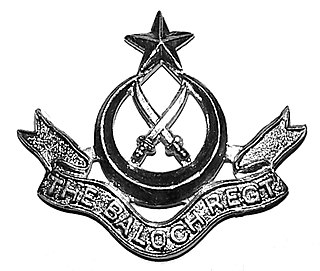
The Baloch Regiment is an infantry regiment of the Pakistan Army. The modern regiment was formed in May 1956 by the merger of 8th Punjab and Bahawalpur Regiments with the Baluch Regiment. Since then, further raisings have brought the strength of the Regiment to 27 battalions. The Baloch Regiment is descended from the infantry of the old British Indian Army and is named after Balochistan. Before 1991, it was called the Baluch Regiment but the spelling was changed to 'Baloch' to better reflect the correct pronunciation.

Lieutenant General Harbaksh Singh, VrC was an Indian senior military officer. As the commander of the Western Command, Singh commanded the Indian Army and played a key role during the Indo-Pakistani War of 1965. For his role in the war, he was awarded the Padma Vibhushan in 1966.
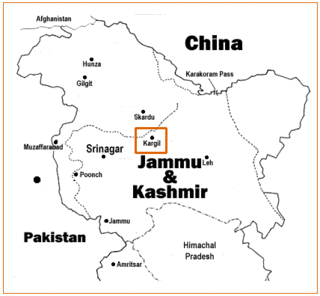
The Kargil War order of battle (KWORBAT), is a deposition and systematic combatant structure of the Indian Army troops and the unified Pakistan Armed Forces combat commands, active in the Kargil region in 1999, during the Kargil War. The Indian Army orbat is based on the publications provided by the Indian military authors, news media and official sources.

The 66th Punjabis was an infantry regiment of the British Indian Army. It was raised in 1761 as the 7th Battalion of Coast Sepoys. It was designated as the 66th Punjabis in 1903 and became 2nd Battalion 1st Punjab Regiment in 1922. In 1947, it was allocated to the Pakistan Army, where it continues to exist as 2nd Battalion The Punjab Regiment.
The Punjab Irregular Force (PIF) was created in 1851 to protect the NW frontier of British India. It was termed "Irregular" because it was outside the control of the Regular British East India Company Presidency armies of the three Presidencies of Bengal, Bombay or Madras, but was under the control of the British chief magistrate of Punjab, known as the President of the Board of Administration from 1849, then as the Chief Commissioner from 1853. Its soldiers were not subject to parade ground drill and showed unconcern towards routine orders given to regiments of the line. They practiced swift tactical movements in small groups, showing special elan and flair. It comprised the various regiments raised earlier for the same purpose on the orders of General Charles James Napier and Col. Sir Henry Montgomery Lawrence between 1843 and 1849 of the former Frontier Brigade established in 1846 and Transfrontier Brigade established in 1849. In 1865, the PIF was redesignated Punjab Frontier Force and in 1903 became the Frontier Force. In 1922 it was split into 2 separate units: the 12th Frontier Force Regiment and the 13th Frontier Force Rifles. In 1947, both were ceded to the new state of Pakistan, which in 1957 amalgamated them, together with a 3rd unit, the Pathan Regiment which Pakistan had earlier created from elements of both, to form the Frontier Force Regiment. Within the latter regiment, the first 15 of its 52 battalions can trace their origins back to original British Army regiments, and the regiment still maintains the lineage of its predecessor British regiments. Members of the PIF traditionally referred to themselves with pride as "Piffers", a tradition very much maintained within the Pakistan Army.

The Bahawalpur Regiment was a regiment of Pakistan Army. The regiment was formed in 1952 from the infantry battalions of the erstwhile Princely State of Bahawalpur, which had acceded to Pakistan in 1947. In 1956, the Bahawalpur Regiment was merged with the Pakistan Army

